Youth Football Online
The Promotion & Instruction of Youth Football
0 items
-$0.00
Home / The Air Raid Offense Series: Turn the Tide | Plays & Playbook
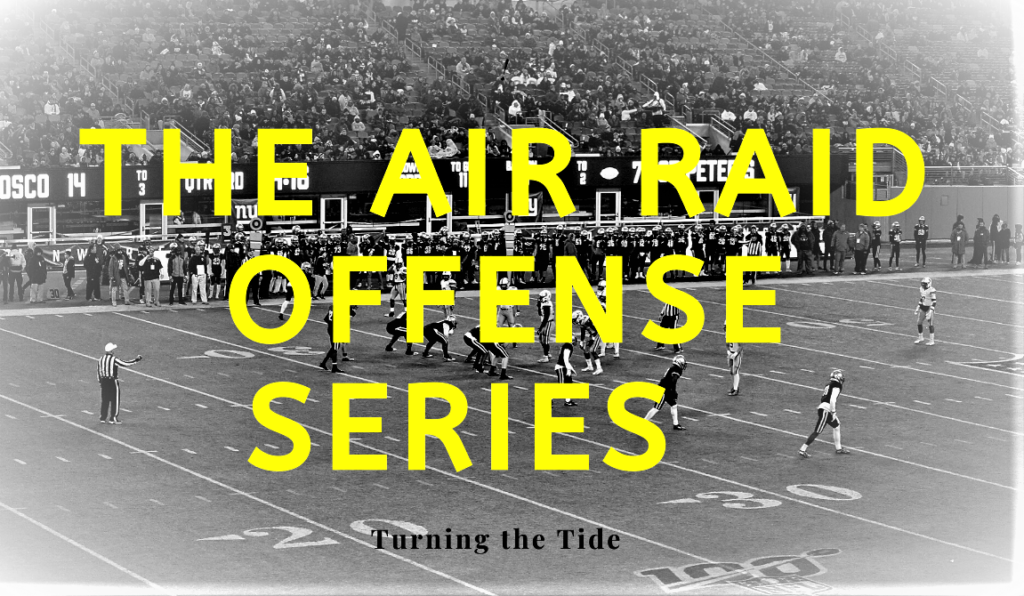
The Air Raid Offense Series: All around our great country participation numbers in tackle football are down, especially in the youth ranks. The health of the game, the pipeline of the future lies directly on the youth programs of America. We need to do everything we can to attract players to the field. Parents no longer giving their athletes the option to play football is a huge factor, but I firmly believe that many athletes don’t fight for the right to play football due to the style the game is being played.
It is a sport that, at the youth level, traditionally features one or two featured players, typically at running back or quarterback who fit a very specific profile. Youth athletes come in all shapes, sizes and skill sets. With the amount of options kids now have today, they won’t engage in a sport unless they are directly a part of the action.
Implementing an offense that can potentially give the ball to 6 different players on any play can certainly help keep more players engaged and potentially bring new athletes in. The Air Raid offense is simple enough for Middle School players to master and so fun to play it captures their imagination. It allows them to play in the style of their heroes who play High School, College and in the Professional ranks.
Throughout Air Raid Offense Series I will explain the core principles of the offense, include the offensive concepts that enable Middle Schoolers to thrive and also try to convince you that, not only are your kids are capable of playing this brand of football but more importantly, they deserve to!
When the dust settled after our first year in the Air Raid offense series, the San Ramon Valley Thunderbirds Varsity (U14, 8th grade) team had brought home the Northern California Championship. The offensive numbers were staggering. Finishing 10-2, the passing game put up 1655 yards with 29 touchdowns. The rushing attack posted 1447 yards, scoring 14 touchdowns. 37% of our plays were defined as Explosive (12+ yard runs/15+ yard passes).
Our point differential was +199, but the most important stat was that 14 different players on our team caught passes, 6 of which caught touchdowns. 12 different players ran with the ball, 6 of which scored touchdowns. As I will get into shortly, the magic behind the Air Raid offense is that on every single pass play, one of six players may get the ball. When your offense comes to the line of scrimmage, every player is engaged, looking for simple defensive keys. After the snap, every player is running their route full speed because they may get the pass.
Core principles of the Air Raid Offense Series to keep in mind:
In the Air Raid offense there are 4 facets of offense. The Quick Game, Drop Back Game,
Screen Game and the Running Game from the Air Raid Offense Series
Let’s continue on in the Air Raid Offense Series so I can show you specifically how to dominate using the system. I hope this introduction to the Air Raid philosophies and fundamentals has been helpful and may make you consider it as an option for your Middle School team(s). The Spread Offense is not going anywhere. In fact, the majority of High Schools are running a version of it. The goal of youth football is preparing your players for High School and this is a way to do just that. It creates an atmosphere where players of all skill sets can make exciting plays in a tackle football game and make highlights previously only available to them in flag and 7v7 games. This in turn, could help turn the tide of participation back in the right direction for our great game! Join us for the next installment and check out the 3 Quick Game concepts your kids will score a ton of points running.
In the Air Raid Quick Game, no matter what concept is called, if the opponent wants to give you free yards (easy money as we call it), take it and don’t stop taking it until they adjust. When the QB comes up to the LOS during the pre-snap process, he looks backside to see if the defense is handing out any “easy money”. If the defenders over the two backside receivers (in the example below, L and F) is 7 yards or more off, the QB will snap the ball and fire it out to that specific receiver, who is running a three-step hitch. Since most coaches in youth football put their weaker players at CB, this means one of my best athletes has the ball in their hands against a less skilled player. We have accomplished our core goal of getting our athletes the ball in space without even running the play we called. After they have made an adjustment, we can go ahead and run our play.
We will show these plays against the two most common defenses we see, the 5-3 Cover 3 and 4-4 Cover 3. Only in the final game of the season did we see a 2 High Cover 2 look. This offense is tailor made for youth football defenses that are not ready to defend a true passing offense.
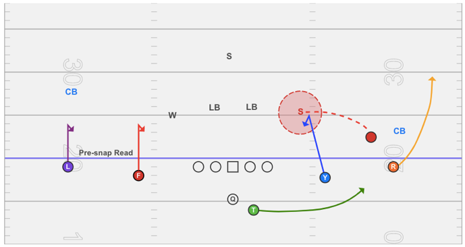
Formations:
Routes:
Post Snap Progression:
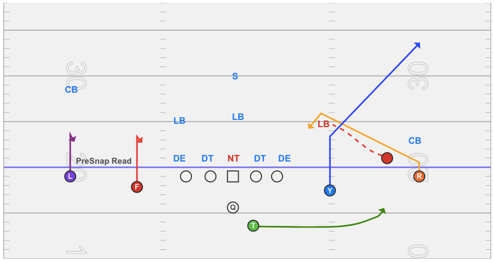
Formations:
Routes:
Post Snap Progression:
As you can see, on two of our core QG (quick game) plays our players are reading the exact same grass areas on the field (deep third, flats, hook/curl). The QB is not learning anything new, the receivers are simply running different routes per the pay that is called. Additionally, out of the three formations we run these plays out of, the routes and reads continue to stay exactly the same on each of the plays. These reads and plays stay very consistent for the players so there is less thinking and they can just go make plays and have fun.
The final Quick Game concept every Middle School Air Raid team needs is All Verticals. Yes, that is not a typo, we run All Verts as a Quick Game concept. There are different schools of thought on this but we have adopted Coach Patrick Taylors way of teaching it because is marries so well with our Quick Game “easy money” philosophy. In the same way the QB comes up to the line and looks backside for “easy money” in our other Quick Game concepts, the QB will do the same with All Verts, except every single receiver is playing by those rules. The only difference being that if the defender covering them is 6 yards or less, that receiver is then running to the open grass behind them on a Go route. It can look like 20 different plays to the defense, but it is only one to us, all depends on how the defensive players are aligned pre-snap. As with every other Quick Game concept, once the defense adjusts and aligns pre-snap to 6 yards or less on all of our receivers, we will adjust as well.
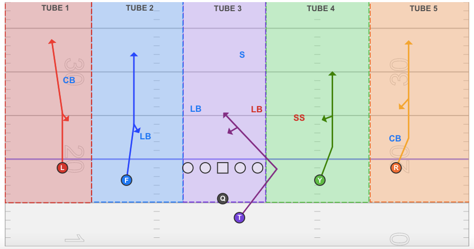
Formations:
Routes:
Post Snap Progression:
The Quick Game passing concepts are all extremely similar in nature. The rules and reads pre-snap are the same. The QB’s open grass reads post-snap are the same. The receiver’s rules of finding open grass are all the same. As you can see, the QB can very simply read open grass and efficiently hit one of three receivers on each of these QG concepts. In the same way the triple option leveled the playing field for undersized and outmatched team in previous eras, Air Raid levels the playing field in today’s game. I have even heard of this offense referred to as the triple option of the passing game. These passing concepts all play off one another and can be used strategically to dominate any defense seen at the Middle School level. Join us for the next installment of this series when we show you the Drop Back Game concepts your kids will love scoring with!
Since the Drop Back Game (DGG) concepts take a bit longer to develop, we only use two at the Middle School level. In the DBG, the QB is not looking for “easy money” throws pre-snap. The offense is coming to the line and running the play called by the OC. We call DBG concepts for a very specific reason… typically a defensive look we like, or we are behind schedule and in need of a larger gain.
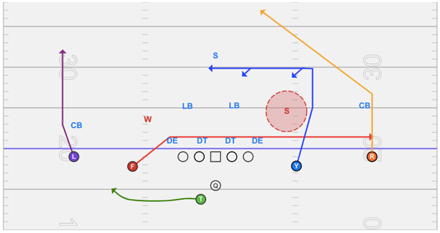
Formations:
Routes:
Post Snap Progression:
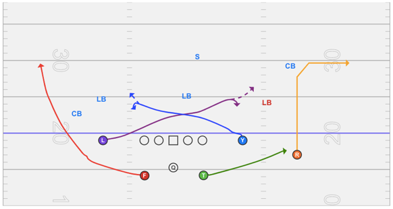
Let’s review what some refer to as “The Perfect Pass”, the Mesh concept. The Mesh play has become a staple at every level of football. The Patriots, Packers and Chiefs have all run during these 2019/20 playoffs. There are many varieties of the play as it has evolved over the past 20+ years, but the way we run it, plus the progressions we adhere to, is actually the way it was originally run by Mumme.
Formations:
Routes:
Post Snap Progression:
While we call Quick Game concepts on a more consistent basis, the Drop Back Game concepts are extremely important to have in the arsenal. These are great man beaters and situational calls that can change the game. As with all of our passes, these are short passes that turn into large gains. There may be nothing prettier that a player catching a 5 yard Shallow and turning it up field for a large gain. Please do take the time to watch the videos I created for our players, as there are some coaching points that are better explained while watching film. Join us for the final installment of this Middle School Air Raid series where we talk Running Game!
There is no, one Run Game of choice in the Air Raid Offense Series. Most coaches will run plays they are comfortable with and can coach up. That being said, there are a few rules that Air Raid teams share. Most only have 3 rushing concepts such as Iso, Power or Zone that cover the need to execute an inside run, outside run and a misdirection. I am going to share what I have personally seen work at the Middle School level, but I am confident that if take your knowledge from your run game of choice, you will be successful at it within this offense. Since Middle School teams primarily play a 5-man front, we attack Off Tackle and Outside with Gap Schemes concepts.
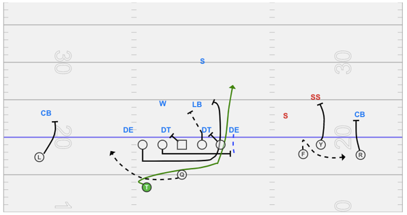
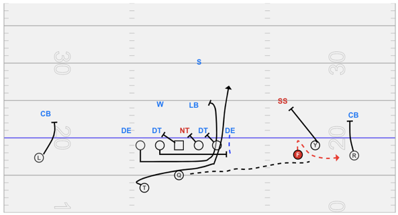
Formations:
Routes:
Pre Snap Progression:
As the QB comes to the LOS, he will look at the Trio set. If we have a numbers advantage (3 on 2, safety doesn’t count), he will throw the Bubble Screen. If they have put another defender out there and it is 3 on 3, he will say “you, you” to the T and we will run the GT Counter.
COACHING NOTES: We didn’t combine GT Counter with our Bubble Screen last year but once again I am stealing from Joe Salas as I saw his video on this and it makes too much sense to not do it. We run the counter toward the Trio side so that overhang defender is put in conflict and he has to declare either way. We consider the Bubble Screen our outside run concept. We do run Fly Sweep but since that takes very little time to install, we rep Bubble way more. We also run Counter without the Tackle pulling at times for various reasons as well.
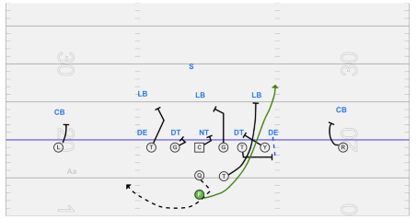
Formations:
Responsibilities:
Coaching Points: Short yardage play. Bootleg, play action pass off of it. We do have a blocking option that automatically kicks in depending on the DL alignment. If the play side DT is over the Guard, the Guard will down block, the TE will go up to the LB and the T will kick out the DE.
I hope this Air Raid Offense Series has given you some ideas that can help your Middle School passing attacks. I am crossing my fingers that I may have convinced a few of you that your team deserves to go full Air Raid! Your players will thrive in it and you can coach it up! I understand it is hard to completely change the offense you have coached for years, and likely grew up within but the game has changed. With the amount of information available on the internet, we have the ability to immerse ourselves in anything we are motivated to learn. 95% of my education came directly from YouTube videos and articles by Coach Ron McKie, Coach Patrick Taylor and Coach Joe Salas. I grew up in the Wing T but have fallen in love with the fact that I am empowering my youth football players to play in a true spread offense and post highlights they only dreamed possible in flag and 7v7. In turn, that may just capture the imagination of other youth athletes who now see that it is possible to do these things in a Middle School tackle football game. I hope this Middle School Air Raid Offense Series has helped you gain some insight into this high-powered offense.
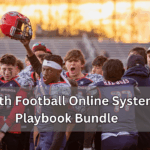
Youth Football Online was created by Coaches Jeff Hemhauser and Vin Sehgal in 2010. Want to contribute content? Contact us if you are interested in contributing content.
All children will learn life lessons from participating in youth football. Join our Movement today.

Copyright ©2023 Youth Football Online. All rights reserved.